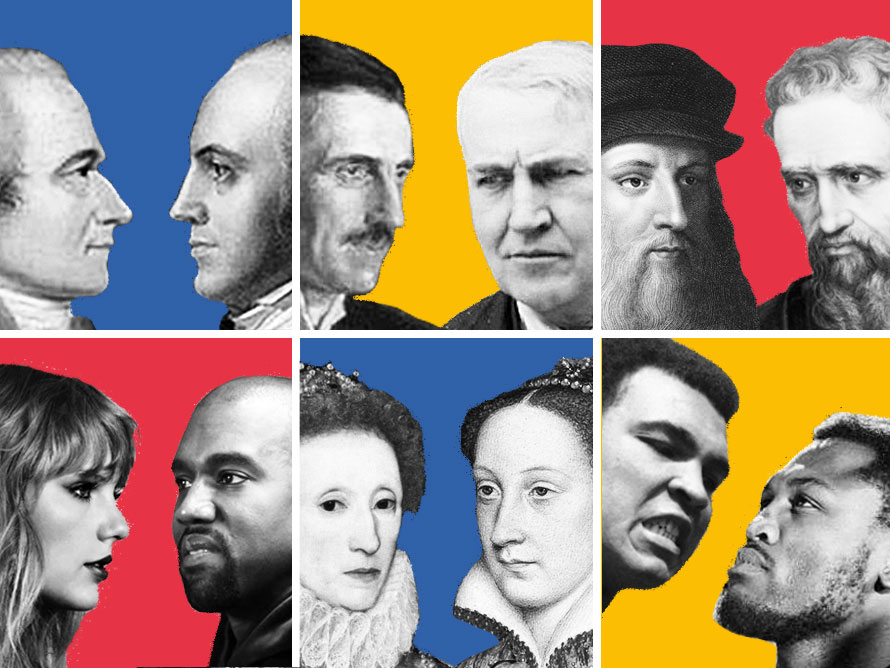Everyone needs a nemesis. Or do they? Social media is abuzz with the idea. And history is full of arch rivals who pushed each other to be better, or drove each other to death.
#Nemesis: ‘better than a friend or a lover’
Everyone needs a nemesis. Or do they? Social media is abuzz with the idea. And history is full of arch rivals who pushed each other to be better, or drove each other to death.
It all began with the writer Roxane GayThe author of several books - most famously, Bad Feminist, a collection of essays on feminism., who has been tweeting about her unnamed "nemeses" for years. "Happy Valentine's Day to everyone but my nemesis," she wrote in February. Earlier, in December 2018: "My nemesis is shining today. Plotting to defeat her." Way back in 2011, at a Scrabble tournament: "My nemesis just showed up. I want to destroy him."
Now the idea has caught on. This week, The Atlantic published an article by the journalist Taylor Lorenz entitles, "Get yourself a nemesis."
"A nemesis is a special kind of foe," she explains. "It's not someone you hate with every inch of your being: [...] you compete with them." In the end, they "push you to work harder".
She cites a 2014 studyThe study conducted two tests on 50 students. At the beginning of the experiment, half were given a cup of tea, and half a glass of water. The groups were then given creative challenges, like coming up with a "cool" name for a noodle restaurant. which found that runners are about five seconds per kilometre faster when competing against a top rival. Lorenz writes that since she selected another journalist to be her own nemesis, "I've noticed myself working harder and putting in longer hours."
Of course, the idea is nothing new. History is filled with famous rivals.
Today, Michelangelo and Leonardo da Vinci are remembered as two of the greatest artists ever to live. When they were both alive in Renaissance FlorenceA period of European history between the 14th and 17th centuries. It was a time of artistic and scientific discovery, much of it taking place in Italy. Leonardo da Vinci and Michelangelo both criticised each other's work, and both were hired to paint the walls of the Palazzo Vecchio in Florence, in competition with each other., their rivalry was so intense that Leonardo left for France just to escape it.
Nikola Tesla and Thomas Edison were pioneers of electricity. Their ACDCNot the rock band! AC stands for "alternating current", Tesla's idea for an electrical charge which changes direction. DC is "direct current", Edison's preferred option in which the charge flows in one direction. Now, both types are used for different things. feud over the best way to deliver electrical currents is legendary.
The day after Edison died, Tesla told The New York Times that Edison was a genius, but that his methods were inefficient, and he "lived in utter disregard of the most elmentary rules of hygeine".
The rivalry between cousinsMary was the granddaughter of one of Henry VIII's sisters. The pair were queens of England and Scotland at the same time. Elizabeth I and Mary, Queen of Scots dominated British politics in the 16th century and was made into a Hollywood film last year. It ended when Elizabeth (somewhat reluctantly) sentenced Mary to death.
Meanwhile, the story of US Founding Fathers Alexander Hamilton and Aaron Burr has gained new fame through the musical Hamilton. their political rivalry also ended in bloodshed: Burr shot and killed Hamilton in a duel in 1804, destroying his own reputation in the process.
Everyone needs a nemesis. Or do they?
Of course, no one thinks that Gay actually wants to hurt her nemeses. For her and Lorenz, it is a fun way to push themselves to new heights. "I am able to be kind, to be wildly productive AND have 9 nemeses who I will bring down," Gay tweeted. "It's fine if you think it's silly."
But is it really healthy to pit yourself against other people? The examples from history are extreme, but they have a serious point: true rivalries can end up consuming people, destroying their careers or even ending their lives. Perhaps the only person you should compete with is yourself.
Keywords
Roxane Gay - The author of several books - most famously, Bad Feminist, a collection of essays on feminism.
Study - The study conducted two tests on 50 students. At the beginning of the experiment, half were given a cup of tea, and half a glass of water. The groups were then given creative challenges, like coming up with a "cool" name for a noodle restaurant.
Renaissance Florence - A period of European history between the 14th and 17th centuries. It was a time of artistic and scientific discovery, much of it taking place in Italy. Leonardo da Vinci and Michelangelo both criticised each other's work, and both were hired to paint the walls of the Palazzo Vecchio in Florence, in competition with each other.
ACDC - Not the rock band! AC stands for "alternating current", Tesla's idea for an electrical charge which changes direction. DC is "direct current", Edison's preferred option in which the charge flows in one direction. Now, both types are used for different things.
Cousins - Mary was the granddaughter of one of Henry VIII's sisters. The pair were queens of England and Scotland at the same time.
#Nemesis: ‘better than a friend or a lover’

Glossary
Roxane Gay - The author of several books - most famously, Bad Feminist, a collection of essays on feminism.
Study - The study conducted two tests on 50 students. At the beginning of the experiment, half were given a cup of tea, and half a glass of water. The groups were then given creative challenges, like coming up with a "cool" name for a noodle restaurant.
Renaissance Florence - A period of European history between the 14th and 17th centuries. It was a time of artistic and scientific discovery, much of it taking place in Italy. Leonardo da Vinci and Michelangelo both criticised each other's work, and both were hired to paint the walls of the Palazzo Vecchio in Florence, in competition with each other.
ACDC - Not the rock band! AC stands for "alternating current", Tesla's idea for an electrical charge which changes direction. DC is "direct current", Edison's preferred option in which the charge flows in one direction. Now, both types are used for different things.
Cousins - Mary was the granddaughter of one of Henry VIII's sisters. The pair were queens of England and Scotland at the same time.
